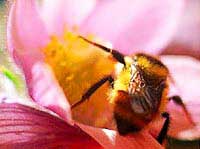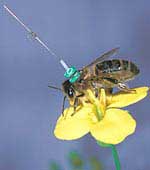 The strange belly dance performed by bees upon returning to the hive serves to inform other bees about the location of food sources they have just visited.
The strange belly dance performed by bees upon returning to the hive serves to inform other bees about the location of food sources they have just visited.
The latest findings from British researchers have proven that a hypothesis proposed in the early 1960s is indeed correct. This hypothesis had been met with skepticism as people doubted that bees could decode such complex messages.
Beekeepers have long been puzzled by the mysterious performances of bees. After completing their nectar-gathering tasks, a bee performs a dance consisting of eight movements by shaking its abdomen. Other bees gather around to closely observe this performance.
“At first glance, it seems chaotic and disorganized. But upon closer inspection, you will notice a distinct and systematic pattern,” said study author Joe Riley from the Rothamsted Research Institute in the UK.
It wasn’t until the 1960s that a new hypothesis was introduced to explain the purpose of the dance. Nobel Prize-winning zoologist Karl von Frisch claimed that the dancing bees convey a complex message that guides others on how to find food sources.
The direction the bee faces during the dance indicates the direction of the food source relative to the sun, while the intensity of the abdomen shake indicates the distance, von Frisch hypothesized.
This hypothesis was tested by taking bees to an artificial food source and observing whether their dance accurately described the location. The results confirmed this. However, some scientists remained skeptical that other bees would follow the instructions correctly, as decoding the dance was thought to be too challenging.
 In reality, it took the bees much longer than expected to reach the food source. This led some researchers to suggest that the dance may serve a simpler purpose. Perhaps they dance to attract the attention of other bees in the hive, which then recognize the scent of the food source and go in search of it by smell.
In reality, it took the bees much longer than expected to reach the food source. This led some researchers to suggest that the dance may serve a simpler purpose. Perhaps they dance to attract the attention of other bees in the hive, which then recognize the scent of the food source and go in search of it by smell.
However, the latest tests have proven that Professor von Frisch was correct. Riley and his team equipped the observed dancing bees with radar devices and tracked their foraging routes. They found that the bees flew directly to the location. To verify, the bees were taken to an area 250 meters away from the hive, and they again flew straight to the foraging site, demonstrating that they accurately followed the instructions in the dance.
“The results strongly support von Frisch’s hypothesis, as in this case, the bees could not have followed a familiar route or the scent left by the dancer,” Riley stated.
Riley’s team also discovered why the bees took longer than anticipated to reach the food source. They found that although the bees flew directly to the site, they took longer to land. This was because the scentless artificial environment made it difficult for them to locate the flowers.
M.T.


















































